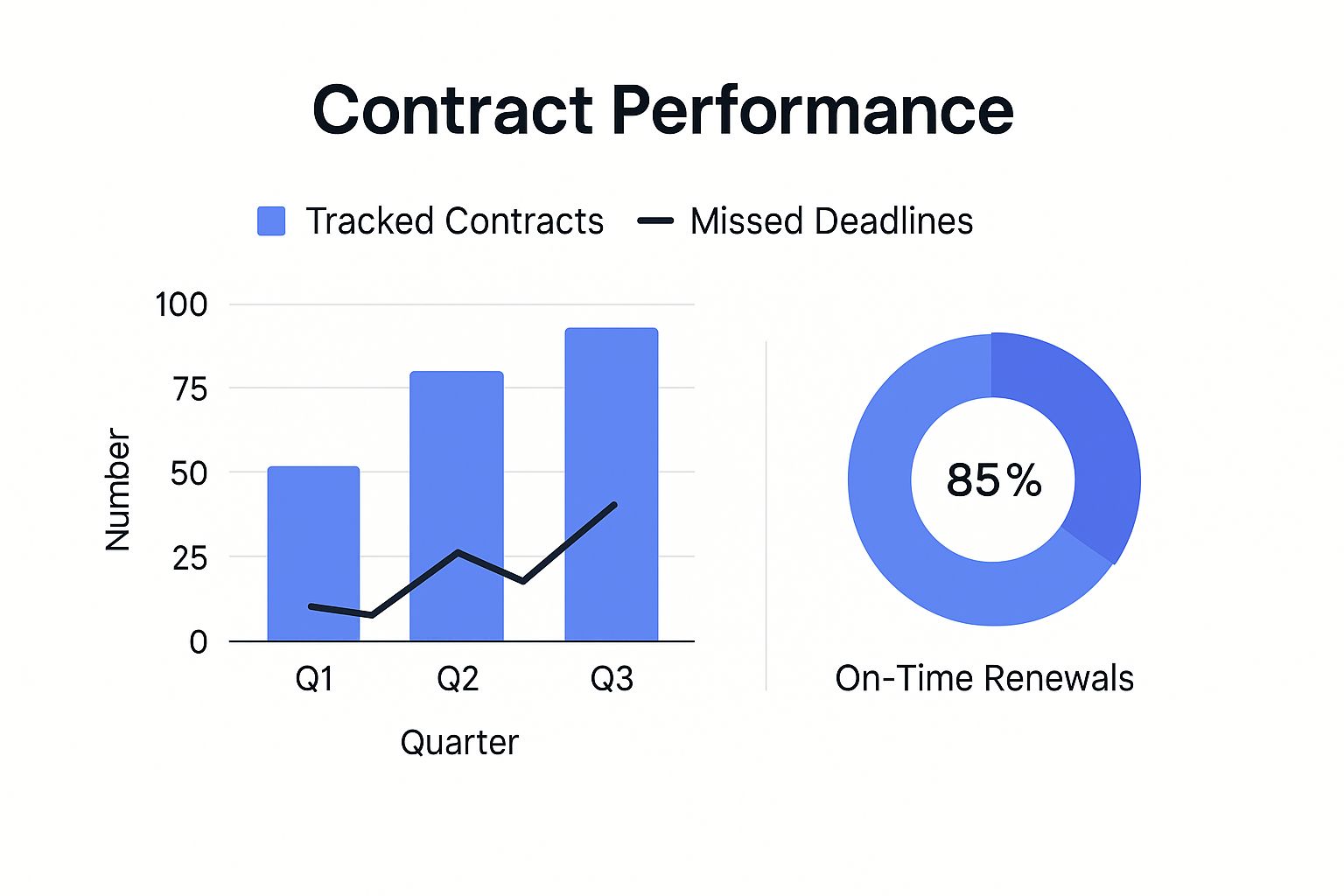
Why Tracking Contract Obligations Is More Critical Than Ever
In today's rapidly evolving business world, organizations often juggle numerous contracts. Keeping track of these contractual obligations has become essential for success. This goes beyond simple administrative tasks; it directly affects a company's financial health and reputation.
Imagine a company forgetting to renew a vital supplier contract. This could disrupt operations, impacting production and, ultimately, profits. This highlights why robust obligation tracking is crucial in today's intricate business landscape.
The Real-World Impact of Robust Obligation Tracking
Discussions with seasoned contract managers highlight the benefits of diligent obligation tracking. They stress how proactive deadline management prevents costly penalties and builds stronger relationships with vendors and partners.
Furthermore, a clear overview of all contractual commitments allows businesses to spot potential risks and opportunities. This proactive approach allows businesses to focus on strategic goals instead of scrambling to meet last-minute deadlines. They can then fully utilize their contracts for maximum benefit.
The infographic below shows the connection between tracked contracts, missed deadlines, and on-time renewals across three quarters.

As the infographic demonstrates, better tracking leads to fewer missed deadlines and higher on-time renewal rates. This data clearly shows the link between diligent tracking and positive business outcomes.
The Growing Complexity of Contract Compliance
Organizations face significant challenges in tracking contract obligations due to the sheer volume and complexity of the contracts they handle. The importance of effective contract management has grown considerably in recent years. Almost 90% of respondents in a recent compliance survey reported increased compliance responsibilities over the past three years. These responsibilities include managing contract terms, ensuring regulatory compliance, and mitigating risks tied to non-compliance. The potential fallout from failing to meet these obligations can be severe, impacting both finances and reputation. For further insights into these growing compliance demands, explore PwC's Global Compliance Survey.
To better understand the potential ramifications of non-compliance, let's examine a breakdown of the potential costs. The table below illustrates various types of non-compliance and their associated impact.
The Rising Cost of Contract Non-Compliance This table presents the potential costs and consequences when organizations fail to properly track and meet their contract obligations.
| Type of Non-Compliance | Financial Impact | Reputational Impact | Operational Impact |
|---|---|---|---|
| Missed Deadlines | Late fees, penalties, loss of discounts | Damaged relationships with vendors/partners | Project delays, disrupted workflows |
| Auto-Renewal Oversights | Unwanted contract extensions, unexpected costs | Loss of trust with clients | Resource allocation issues |
| Breach of Contract | Legal fees, litigation costs, damage payments | Negative publicity, diminished brand image | Loss of business opportunities, operational shutdowns |
| Regulatory Non-Compliance | Fines, penalties, legal action | Reputational damage, loss of licenses | Operational restrictions, increased scrutiny |
This table underscores the wide-ranging consequences of contract non-compliance, affecting everything from finances to reputation and operations. Proactive contract management is crucial for mitigating these risks.
Transforming Compliance From Burden to Advantage
Progressive companies are transforming contract compliance from a necessary evil into a strategic asset. They achieve this by using systems that not only track obligations but also offer valuable insights.
Automated alerts for approaching deadlines, for example, allow teams to proactively address obligations and prevent potential breaches. Centralized contract repositories provide a single source of truth, simplifying access to information and encouraging collaboration across departments. This shift allows organizations to use contract compliance to boost efficiency and improve overall performance.
Quantifying the Cost of Obligation Failures
Understanding the financial repercussions of missed obligations is key to showing the value of effective tracking. By quantifying the potential costs of penalties, legal battles, and lost opportunities, organizations can justify investing in robust tracking systems. But the cost isn't only financial. Reputational harm from non-compliance can erode customer trust and affect future business.
This underscores the importance of a comprehensive, proactive approach to contract obligation management. Tools like Legal Document Simplifier can automate this process, saving time and resources. Explore the advantages of effective contract management and its effect on compliance by visiting Contract Management Best Practices.
Breaking Through the Contract Tracking Chaos

Many organizations struggle to effectively track contract obligations. These often complex commitments, buried within legal language, have a significant impact on business operations, finances, and reputation. This section explores the daily challenges contract managers face, from fragmented systems creating blind spots to unclear ownership of key obligations.
The Perils of Fragmented Systems
One of the biggest obstacles is the use of multiple, disconnected systems for contract storage and management. This fragmentation makes it incredibly difficult to get a complete picture of all contract obligations. Imagine a company using separate systems for sales contracts, vendor agreements, and relying on spreadsheets for internal agreements. This creates information silos, leading to missed deadlines, overlooked renewals, and potential contract breaches. Critical obligations can easily fall through the cracks, exposing the organization to unnecessary risk.
The Ownership Dilemma
Another common problem is unclear ownership of contract obligation tracking and fulfillment. When several departments interact with a single contract, obligations can fall into a gray area where no one takes responsibility. Manual tracking with spreadsheets is prone to errors and inconsistencies. This lack of clarity and reliance on outdated methods increases the chance of overlooking crucial obligations. Contract obligations are tied to overall contract document management. For more information, see: Document Lifecycle Management.
Why Traditional Approaches Fail
Traditional contract management often relies on manual processes and outdated technologies. These methods simply can't handle the increasing volume and complexity of contracts in today’s business environment. They lack the scalability and automation needed for efficient tracking. They also hinder visibility and collaboration, making it difficult for stakeholders to stay informed and meet commitments.
Prioritizing Obligations Based on Risk
Successful companies are shifting away from generic approaches to contract obligation management. They are prioritizing obligations based on potential impact. By implementing risk-based frameworks that assess the likelihood and severity of non-compliance, they can strategically allocate resources. This targeted approach focuses on the obligations that pose the greatest risk to the organization, ensuring the most critical commitments receive proper attention and mitigating potential problems before they escalate. In the area of trade compliance, tracking contract obligations is especially crucial, given the increasing complexity of global sanctions and export controls. By 2025, businesses will need to adapt to rapidly changing regulations to mitigate compliance risks. This requires robust mechanisms like denied party screening. Explore this topic further: Learn more about trade compliance trends.
Building a Contract Obligation System That Actually Works

This section explores the practical side of building a successful contract obligation tracking system. We'll look at how organizations effectively blend automation with human oversight for the best results. The goal isn't just about checking off requirements; it's about building a system that actively manages commitments and boosts business value.
Centralized Repositories: The Single Source of Truth
At the heart of any effective tracking system lies a centralized repository. This creates a single, reliable source for all contract information, eliminating the confusion of scattered spreadsheets and shared drives.
Imagine a sales team needing immediate access to a client agreement. A centralized repository lets them quickly locate the right version and specific details, streamlining their workflow and preventing miscommunication. This easy access is essential for efficient collaboration across departments. For more insights, check out this resource: How to master contract management best practices.
Smart Notifications: The Right Information at the Right Time
A strong notification system is crucial for proactive obligation management. These systems alert the right people at the right time about upcoming deadlines, milestones, and necessary actions.
This proactive approach prevents obligations from being overlooked and guarantees timely fulfillment. Automated reminders also ease the workload on contract managers, allowing them to focus on strategic initiatives. Ultimately, this reduces the risk of missed deadlines and potential penalties.
Actionable Reporting: Driving Results, Not Confusion
Effective reporting provides more than just data; it delivers actionable insights. Reports should clearly display the status of obligations, highlight potential issues, and track performance against key metrics.
This allows stakeholders to grasp the overall state of their contracts and make informed decisions. For example, a report consistently showing missed deadlines for a certain vendor could initiate a review of the relationship or prompt corrective actions. This data-driven approach empowers organizations to fine-tune their contract management processes.
Role-Based Access: Security and Collaboration
Role-based access control is key for maintaining data security while promoting effective collaboration. By setting specific permissions for different users, organizations safeguard sensitive information.
At the same time, it allows authorized personnel across departments to access the information they need to meet their obligations. This balance of security and accessibility encourages teamwork across different functions and strengthens overall contract management.
Real-World Implementation: Success Across Industries
Businesses across diverse sectors have successfully improved their obligation management using these principles. For example, a manufacturing company implemented a centralized repository and automated notifications, resulting in a 60% reduction in missed delivery deadlines. A healthcare provider used role-based access to protect patient data while enabling efficient collaboration among medical staff on contract-related obligations. These examples showcase the real-world advantages of a well-designed contract obligation tracking system.
Comparing Manual vs. Automated Tracking
To better understand the benefits of automation, let's compare manual and automated contract obligation tracking. The table below outlines key differences across various performance indicators.
| Performance Indicator | Manual Tracking | Automated Tracking | Improvement Potential |
|---|---|---|---|
| Accuracy | Prone to human error | High accuracy due to automation | Significant |
| Efficiency | Time-consuming and labor-intensive | Streamlined and efficient | Substantial |
| Visibility | Limited, often fragmented | Real-time, comprehensive visibility | Dramatic |
| Risk Management | Reactive, difficult to identify risks | Proactive, early risk identification | High |
| Cost | Can be surprisingly expensive due to inefficiencies | Cost-effective in the long run | Considerable |
As the table highlights, automated systems offer significant improvements in accuracy, efficiency, and risk management. They also contribute to lower costs over time. This data-driven approach helps businesses move away from manual processes toward a more robust and efficient way to track contract obligations.
Implementing Obligation Tracking That Drives Compliance
This section offers a practical guide to implementing effective contract obligation tracking. We'll move beyond theoretical concepts and delve into real-world applications. This includes exploring how successful organizations identify hidden obligations, build standardized tracking systems, and establish clear accountability.
Conducting Comprehensive Contract Audits
A contract audit is the crucial first step. This process helps uncover hidden obligations often buried in complex legal terms. It's like a detailed investigation, revealing not only explicit commitments but also implied ones. This comprehensive understanding sets the foundation for effective tracking and management.
Developing Standardized Categorization
After identifying your obligations, a standardized categorization system is essential. This ensures consistent tracking and management across your organization. Without a clear system, managing obligations becomes disorganized and inefficient. A well-defined system enables efficient searching, reporting, and analysis, allowing you to quickly pinpoint and address key commitments.
Establishing Clear Ownership Frameworks
Clear ownership is vital for accountability. Assign each obligation to a specific person or team. This eliminates ambiguity and ensures responsibility for every commitment. This clarity promotes better coordination and successful fulfillment of obligations. Learn more about accountability in our article about How to master contract compliance management.
Overcoming Resistance and Securing Buy-In
Introducing new processes can sometimes meet resistance. To secure stakeholder buy-in, address concerns and emphasize the benefits of obligation tracking. Show how the system minimizes risk, improves efficiency, and boosts financial performance. Highlighting how automated reminders can prevent costly penalties, for example, can be particularly persuasive. Involving stakeholders in the implementation process also fosters ownership and increases the likelihood of successful adoption.
Achieving Rapid Adoption for Immediate Risk Reduction
Strive for rapid adoption of your new system. Provide sufficient training and support so users understand the tools and processes. Quick implementation delivers the benefits of improved obligation tracking sooner, minimizing risk immediately. This early success builds momentum and promotes continued system use and improvement.
Real-World Case Studies: Practical Insights
Real-world examples offer practical insights. One retail company dramatically reduced late payment fees by implementing automated reminders for payment obligations. A construction firm improved project timelines by tracking key milestones and dependencies within contracts. These examples illustrate the tangible benefits of effective obligation tracking across various industries. You might also find value in exploring How to master contract management best practices.
By following these steps, organizations can shift contract obligation tracking from a reactive burden to a proactive, value-driven function. This proactive strategy empowers businesses to reduce risk, improve compliance, and unlock the full value of their contracts.
Leveraging Tech That Transforms Contract Obligation Tracking

This section explores practical technology solutions for managing contract obligations, focusing on measurable results. We'll examine how artificial intelligence (AI) and machine learning automate obligation extraction, how predictive analytics helps prevent compliance issues, and the importance of system integrations.
AI and Machine Learning: Automating the Extraction of Obligations
AI and machine learning are changing how businesses handle contract obligations. These technologies automatically extract key obligations from contracts, reducing manual review and human error. This automation speeds up the process of identifying and categorizing obligations.
For example, AI can identify payment schedules, delivery dates, and performance metrics within complex legal documents. This allows contract managers to focus on more strategic tasks, such as risk assessment and planning.
Predictive Analytics: Preventing Compliance Failures Before They Occur
Predictive analytics enhances obligation management by anticipating potential issues. This technology analyzes contract data to identify patterns and predict future outcomes. Organizations can then address potential non-compliance issues proactively.
For example, if a vendor frequently misses deadlines, predictive analytics can flag this, allowing for early intervention. This proactive approach helps reduce risks and avoid penalties. Staying on top of overall HR compliance is also important. Here's an HR compliance checklist.
Smart Integrations: Connecting Contract Data With Critical Enterprise Systems
Smart integrations connect contract data with other crucial systems, such as Enterprise Resource Planning (ERP) and Customer Relationship Management (CRM) platforms. This provides a complete view of contract performance and its impact on the business.
Integrating contract data with financial systems, for instance, can automate payments and improve invoice reconciliation. This streamlines operations and reduces errors. These integrations also provide valuable data for analysis and decision-making.
Evaluating Technology Options and ROI Expectations
Choosing the right technology depends on your organization's unique needs. Consider factors like contract volume, complexity, and your current IT setup. Larger organizations might benefit from comprehensive Contract Lifecycle Management (CLM) systems. Smaller businesses might find AI-powered document analysis tools more suitable.
It's also important to have realistic ROI expectations. New technology requires upfront investment and maintenance. However, the long-term benefits of improved efficiency, reduced risk, and increased compliance often outweigh these costs. Understanding your needs and budget is key to selecting technology that delivers value. This careful evaluation ensures the chosen technology aligns with your goals and resources.
Planning for implementation is also crucial. Training, system integration, and change management require careful planning and execution. Addressing these challenges proactively ensures a smooth transition and maximizes the benefits of new technology.
Measuring Success: The 8 Metrics That Actually Matter
How do you know if your contract obligation tracking is truly effective? It's not just about checking off tasks; it’s about seeing real improvements in your business. This section explores the key performance indicators (KPIs) that matter most, showing how they reveal the effectiveness of your tracking and how top companies use them to constantly improve.
Compliance Rate Metrics: Ensuring On-Time Delivery
The most straightforward measure of success is your compliance rate. This shows how often your organization meets its obligations on time. A high compliance rate points to a strong tracking system and proactive management, demonstrating that obligations aren't being missed. Tracking this over time reveals patterns and areas for improvement. For example, a recurring dip in the compliance rate for certain obligation types could signal a systemic problem needing attention.
Financial Impact: Linking Compliance to Profit
While compliance is key, connecting it to financial outcomes is crucial. Financial impact measurements translate compliance into real monetary results. Calculate the cost of non-compliance, including penalties, legal fees, and lost revenue. Then, compare this to the cost of your tracking system. This comparison reveals the return on investment (ROI) of effective tracking. For instance, if your system helps avoid $100,000 in penalties while costing $10,000 per year, the ROI is significant.
Efficiency Metrics: Streamlining Your Processes
Contract obligation tracking should not only prevent losses but also boost efficiency. Efficiency metrics quantify the time and resources saved by automated tracking. Measure the time spent on manual tracking compared to automated tracking. Also, track the decrease in errors. This data shows the operational benefits of your system. Reducing manual processing time frees up your team for more strategic tasks. If automated tracking cuts contract review time by 50%, for example, that's a major productivity boost.
Dashboards and Benchmarks: The Path to Improvement
Leading organizations use dashboards to instantly see how their obligations are doing. These dashboards show real-time data on compliance rates, financial impact, and efficiency. They give a clear, concise performance overview, allowing for quick identification of potential problems. Setting relevant benchmarks against industry averages or past performance drives continuous improvement. This comparison helps you see where your organization stands and where to improve. Tools like Legal Document Simplifier can help create these dashboards. For more information, check out our post on Contract Risk Management.
Linking Obligations to Business Goals
Remember, contract obligation tracking isn’t a standalone activity. It should connect to your overall business goals. Show how better tracking contributes to strategic objectives like higher revenue, lower risk, and increased customer satisfaction. This reinforces the value of effective tracking and gets stakeholder buy-in. If improved tracking leads to quicker contract completion, for instance, this can speed up sales and boost revenue. By connecting these dots, you can demonstrate the true value of your contract obligation tracking efforts.
Future-Proofing Your Contract Obligation Management
The world of contract management is always evolving. Is your business ready to adapt? This section explores emerging trends that are changing how we track obligations. We'll delve into how blockchain, natural language processing (NLP), and regulatory changes are impacting tracking across various industries. These insights will help you keep your organization ahead of the curve, maintaining robust tracking no matter how the market shifts.
Blockchain: Creating Immutable Records
Blockchain technology provides a secure and transparent method for recording contract obligations. Imagine a digital ledger that automatically documents every action, creating a permanent, tamper-proof history. This eliminates disagreements about fulfillment and provides a clear audit trail.
For example, when a payment milestone is reached, it’s instantly recorded on the blockchain, offering verifiable proof of performance. This enhanced transparency builds trust between parties and simplifies dispute resolution.
Natural Language Processing (NLP): Revolutionizing Obligation Extraction
Contracts are often full of complex legal terminology. NLP helps by automatically pulling out key obligations from these documents. It’s like having an AI assistant that reads and interprets your contracts, identifying crucial dates, deadlines, and responsibilities.
This reduces the need for manual review, which saves time and minimizes human error. NLP also helps standardize obligation identification, creating more consistent tracking and reporting.
Regulatory Changes: Adapting to New Requirements
Regulations are constantly changing, and this impacts how businesses track contract obligations. Staying updated on these changes is essential for maintaining compliance. For example, new data privacy regulations may necessitate stricter monitoring of data processing obligations within contracts.
By proactively adapting to these shifts, businesses can avoid penalties and stay legally sound. For further information on mitigating legal risk, check out this helpful guide on Contract Risk Management.
Staying Ahead of the Curve: Maintaining Robust Tracking Practices
To stay competitive, businesses must embrace these advancements. By integrating blockchain, NLP, and proactive regulatory monitoring into their contract obligation management systems, organizations can:
- Increase Efficiency: Automate time-consuming tasks, minimize manual review, and improve overall workflows.
- Enhance Accuracy: Reduce human error and ensure precise obligation identification.
- Improve Compliance: Stay informed about regulatory updates and avoid costly penalties.
- Build Trust: Generate transparent and verifiable performance records.
- Gain a Competitive Edge: Make informed, data-driven decisions based on readily available information.
This forward-thinking approach sets businesses up for success in today’s complex and regulated business environment.